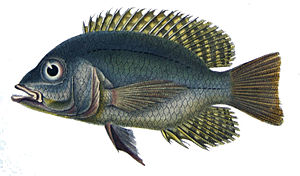Chaetobranchini
| Chaetobranchini | ||||||||||||
|---|---|---|---|---|---|---|---|---|---|---|---|---|

Chaetobranchus flavescens , drawing from Castelnau's Expédition dans les parties centrales de l'Amérique du Sud, de Rio de Janeiro à Lima, et de Lima au Para: exécutée par ordre du gouvernement Français pendant les années 1843 à 1847. - Paris: P. Bertrand , 1850-1857 |
||||||||||||
| Systematics | ||||||||||||
|
||||||||||||
| Scientific name | ||||||||||||
| Chaetobranchini | ||||||||||||
| Fernández Yépez , 1951 |
The Chaetobranchini are a tribe of the American cichlid subfamily Cichlinae . The distribution area extends from the Orinoco and the three Guayanas over the Amazon basin to the catchment area of Río Paraná and Río Paraguay . The Chaetobranchini only have two genera, Chaetobranchus and Chaetobranchopsis , each with two species. The genus Astronotus , which used to be counted among the Chaetobranchini, is now in its own tribe, the Astronotini.
features
Chaetobranchini species are 12 to 24 cm long, have an oval, laterally flattened body and a pointed head. They eat plankton and have only small jaw teeth, but an effective filter apparatus made of fine gill rakes . In contrast to other cichlids, gill spines sit not only on the gill arches, but also on the lower pharynx . However, these are only very small. The lower lip overlaps the rear edge of the upper lip at the corner of the mouth. This lip type ("American-type") is characteristic of New World cichlids (subfamily Cichlinae ). In the case of Astronotus , however, it is the other way round (“African-type” lip). The scaling in front of the dorsal fin is irregular, the rear lateral line extends down to the caudal fin. The last two characteristics are considered typical of primeval cichlids.
literature
- Rainer Stawikowski and Uwe Werner: Die Buntbarsche Amerikas, Vol. 1 Verlag Eugen Ulmer, 1998, ISBN 978-3800172702 , page 79.
Individual evidence
- ↑ Smith, WL, Chakrabarty, P., Sparks, JS, 2008. Phylogeny, taxonomy, and evolution of Neotropical cichlids (Teleostei: Cichlidae: Cichlinae). Cladistics 24, 625-641. DOI: 10.1111 / j.1096-0031.2008.00210.x